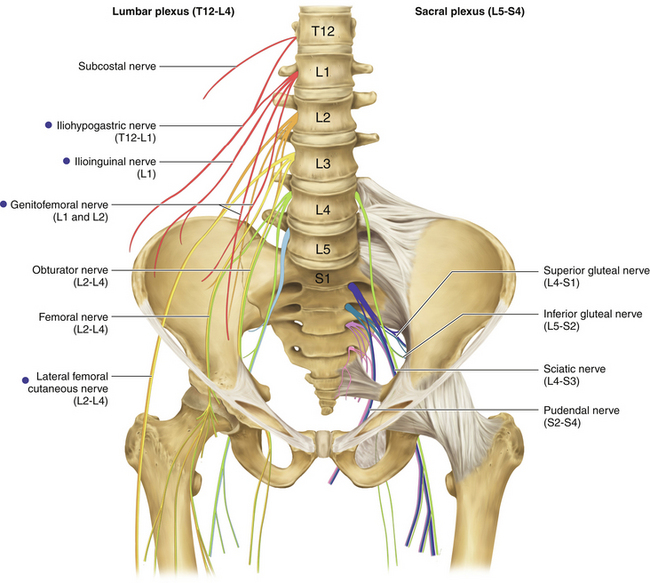Chapter 14 Ilioinguinal, Iliohypogastric, and Genitofemoral Nerves and Lateral Cutaneous Nerve of the Thigh
Sensory Distributions of the Nerves
• These nerves originate from lumbar spinal nerves (Figure 14-1).
• The distribution of sensory changes and the nature of symptoms associated with injuries to these nerves overlap; however, with experience, they can usually be differentiated (Figure 14-2).
• The lateral femoral cutaneous nerve (LFCN) (L2 and L3) supplies the “trouser pocket” area (the anterolateral proximal thigh).
• The ilioinguinal nerve (L1) runs along the spermatic cord in males and the round ligament of the uterus in females. supplies sensation to the region of the symphysis pubis and medial thigh and, in males, to the dorsum of the penis and some of the upper scrotum. In females, the mons pubis and labia majora receive sensory input.
• The iliohypogastric nerve (L1) supplies some sensation to the lower abdominal skin above the pubis and also gives a lateral branch to the superior gluteal area.
• The genitofemoral nerve (L1 and L2) divides into a genital branch, which innervates the cremaster muscle and scrotal skin in males and the round ligament in females, and a femoral branch, which innervates the skin in the region of the femoral triangle (Figure 14-3).
• The LFCN runs across the posterior abdominal wall, across the iliacus behind the iliac fascia, then through that fascia until it enters the thigh behind the inguinal ligament. The relationship of the nerve to the anterior superior iliac spine (ASIS) is variable; it usually lies within 1 inch medial to ASIS but occasionally runs just above the spine or, rarely, through it. Occasionally, the LFCN fascicles will stick to the femoral nerve and enter the thigh more medially than usual. Branches of the nerve pierce the fascia that invests the thigh at variable points, usually about 2 inches distal to the ligament.
• The ilioinguinal nerve runs laterally and down across the posterior abdominal wall to about the level of the iliac crest, where it enters the body wall. The iliohypogastric nerve runs a parallel course, at a higher level. The genitofemoral nerve runs downward on the anterior surface of the psoas major.








